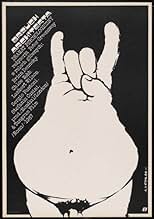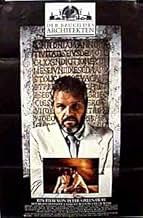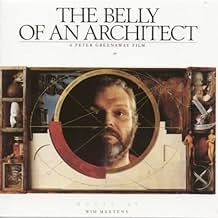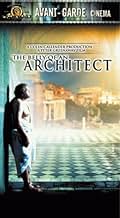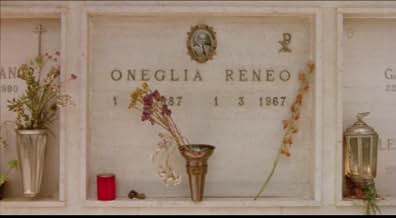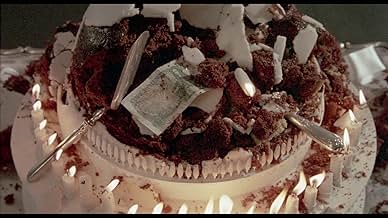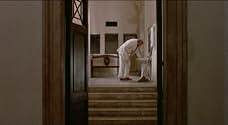VALUTAZIONE IMDb
6,9/10
6553
LA TUA VALUTAZIONE
Aggiungi una trama nella tua linguaAn architect supervising an exhibition starts to have mysterious stomach pains while his life slowly falls apart.An architect supervising an exhibition starts to have mysterious stomach pains while his life slowly falls apart.An architect supervising an exhibition starts to have mysterious stomach pains while his life slowly falls apart.
- Regia
- Sceneggiatura
- Star
- Premi
- 2 candidature totali
Marino Masé
- Trettorio
- (as Marino Mase)
Recensioni in evidenza
Welcome to Greenaway cinema. Having seen only his 'hit' The Cook the Thief His Wife & Her Lover(1989) and this, I cannot say much for the sum of his films. I will simply try to find and watch more film of his. His comments and quotes here in IMDb are impressive as well.
On to the film: Shot in Rome, it will thrill people with interest on architecture both visually, but thematically as well, well at least at some points. The musical score is stunning. It suits the theme and climax that Greenaway masterfully builds. As with The Cook the Thief His Wife & Her Lover, it is not various separate songs. All the soundtrack songs together form a thriumph of visual and audio art, suggesting my point about the importance of film soundtracks for an effective impact on viewer. This is a sad story, but it features some light points where joy and lust for life is celebrated - at least for my eyes and ears.
Those who criticise Greenaway for attempting only to shock the viewers have simply lost the point. Anyway. The Belly of an architect is no violent film, so it is highly recommended to those interested in films, maybe a bit 'arty', but with heart .
On to the film: Shot in Rome, it will thrill people with interest on architecture both visually, but thematically as well, well at least at some points. The musical score is stunning. It suits the theme and climax that Greenaway masterfully builds. As with The Cook the Thief His Wife & Her Lover, it is not various separate songs. All the soundtrack songs together form a thriumph of visual and audio art, suggesting my point about the importance of film soundtracks for an effective impact on viewer. This is a sad story, but it features some light points where joy and lust for life is celebrated - at least for my eyes and ears.
Those who criticise Greenaway for attempting only to shock the viewers have simply lost the point. Anyway. The Belly of an architect is no violent film, so it is highly recommended to those interested in films, maybe a bit 'arty', but with heart .
Why was this film made? Because someone talked Greenaway into trying to go mainstream. By this time, he had already made some of the most adventuresome films in history. This simple confection is sandwiched between `Zed and Two Noughts' and `Drowning by Numbers,' both of which are complex, intelligent, risky, erudite.
I can only imagine that he thought he could finance his serious work with a commercial success. Some might tag this as an accessible Greenaway film, but I hardly think it is Greenaway at all. Nor is the remarkable composer Nyman present.
All that remains are some lush compositions, studies in photographing monumental architecture, and these are pleasant enough. A subtext is fascist perfidy in architecture and the film takes a critical (visual) stance on Roman architecture. See here how all the buildings are from the emperors or Mussolini. No church architecture here which must have been a conscious omission for simplicity.
Everything about the physical fabric portrayed is dehumanizing, especially as compared to the containing space of the skin. As an architect myself, I can appreciate the message. It is a clever conceit, but it pales, utterly fades away, in comparison to his best: `The Falls,' and the `book' films.
I can only imagine that he thought he could finance his serious work with a commercial success. Some might tag this as an accessible Greenaway film, but I hardly think it is Greenaway at all. Nor is the remarkable composer Nyman present.
All that remains are some lush compositions, studies in photographing monumental architecture, and these are pleasant enough. A subtext is fascist perfidy in architecture and the film takes a critical (visual) stance on Roman architecture. See here how all the buildings are from the emperors or Mussolini. No church architecture here which must have been a conscious omission for simplicity.
Everything about the physical fabric portrayed is dehumanizing, especially as compared to the containing space of the skin. As an architect myself, I can appreciate the message. It is a clever conceit, but it pales, utterly fades away, in comparison to his best: `The Falls,' and the `book' films.
The ebullient Brian Dennehy gives a fine performance as Stourley Kracklite, an American architect who is in Rome with his younger wife Louisa (Chloe Webb) to arrange an exhibition on the French architect Etienne-Louis Boullée. Kracklite is obsessed with Boullée and even writes letters to him. Kracklite's life soon begins to deteriorate. He starts to suffer excruciating stomach pains and vomits each time he eats. He even thinks that his wife is poisoning him. His wife then falls pregnant and has an affair with Kracklite's rival architect, Caspasian Speckler (Lambert Wilson). Kracklite then sleeps with Speckler's sister, to get some sort of satisfaction. Speckler intrudes while they are having sex, and announces, "having sex with your pregnant wife is perfect, because I don't need to use contraception". Kracklite then punches him on the nose. Speckler's sister then says, "Don't put your blood on my white towel."
The film follows the parallels of these two unappreciated architects from different eras. The film is memorable for Dennehy's (an actor who is also unappreciated) remarkable performance. Also, the beautiful cinematography by Greenaway's trusty DOP Sacha Vierny makes the film very easy to look at. From the ancient architecture of Rome, to a painting-like bowl of figs, it is pristine-looking. Michael Nyman is absent, but the music by Wim Mertens is splendid. This film was made in between A Zed & Two Noughts and Drowning by Numbers, and it is quite unlike those two films, which, I think, are superior to this in the way they offer us a much more enigmatic, abstract concept. But even an ever so slightly lesser Greenaway film is a thing to behold.
The film follows the parallels of these two unappreciated architects from different eras. The film is memorable for Dennehy's (an actor who is also unappreciated) remarkable performance. Also, the beautiful cinematography by Greenaway's trusty DOP Sacha Vierny makes the film very easy to look at. From the ancient architecture of Rome, to a painting-like bowl of figs, it is pristine-looking. Michael Nyman is absent, but the music by Wim Mertens is splendid. This film was made in between A Zed & Two Noughts and Drowning by Numbers, and it is quite unlike those two films, which, I think, are superior to this in the way they offer us a much more enigmatic, abstract concept. But even an ever so slightly lesser Greenaway film is a thing to behold.
Brian Dennehy and Chloe Webb come to Rome. He's an architect who has been working for ten years on an exhibit about Etienne-Louis Boullee, and it has reached the stage where the physical labor has to be done. As the project moves sluggishly forward, Dennehy can't figure out where the money is going. All he knows is that Roman architect Lambert Wilson is carrying on an affair with Miss Webb, angling to take over the exhibit, and he has new and distressing pains in his gut.
Peter Greenaway directs High Art films that flirt with the limits of watchability -- I've never been able to get past the initial image in PROSPERO'S BOOK, of John Gielgud in hs bath, watered by cherubs like a garden fountain. This one is very watchable, with its bits of color, and Dennehy's solid performance against the wreckage of classical art through the movie's Rome; there's one funny moment when he uses the feet of a colossal sculpture to scratch his back. Yet, in the end, Dennehy's performance takes over the entire movie, leaving everyone else as bit players. Others' motives, except for Lambert's greed, remain obscure. Is Greenaway satirizing the excessive intellectualization of a practical art of which he himself is guilty?
Peter Greenaway directs High Art films that flirt with the limits of watchability -- I've never been able to get past the initial image in PROSPERO'S BOOK, of John Gielgud in hs bath, watered by cherubs like a garden fountain. This one is very watchable, with its bits of color, and Dennehy's solid performance against the wreckage of classical art through the movie's Rome; there's one funny moment when he uses the feet of a colossal sculpture to scratch his back. Yet, in the end, Dennehy's performance takes over the entire movie, leaving everyone else as bit players. Others' motives, except for Lambert's greed, remain obscure. Is Greenaway satirizing the excessive intellectualization of a practical art of which he himself is guilty?
You always know going into a Peter Greenaway film that, for better or for worse, you are going to get something a bit left-field. The Belly of an Architect is really no different in this regard. This one tells the tale of an American architect who travels to Rome with his young wife to supervise an exhibition celebrating the 18th century architect Etienne-Louis Boullée. Very soon after arrival both he and his wife experience contrasting activity in their bellies, for him it is severe abdominal pains while she falls pregnant. To complicate matters, they soon begin affairs with other people. The film essentially then details the architects mental deterioration, which includes writing postcards to his long deceased doppelganger Boullée.
This one has to go down as one of Greenaway's more accessible films. It has an actual story that is underpinned by a good central performance from Brian Dennehy. But its maybe the very fact that it skirts so close to realistic drama that is one of the main problems, as Greenaway is usually best when he does precisely the opposite. The story is really quite boring and the acting aside from Dennehy not all that good – Chloe Webb being particularly flat as his wife; look out also for Stefania (Suspiria) Cassini sporting an unfamiliar cropped 80's barnet. The visuals, while certainly nicely composed, aren't all that memorable. Given that the setting is Rome, there are many shots of that cities peerless architecture, although that all gets almost a bit travelogue to a certain extent. I think this film, therefore, is one for Greenaway devotees almost exclusively as in order to get a lot out of it you have to be interested in his ideas. While I have liked several of his films, I can't deny that, even in the cases of the ones I liked most, his films can be somewhat annoying. Dennehy really helps draw us in to events though and makes a good stab at involving us but it's difficult to care too much about these stiff characters populating a narrative that is both distant and very cold emotionally. Boullée himself is a typically absurd Greenaway figure, in that very little of his architecture ever came to be built, so it's difficult to ever imagine a high profile retrospective of his work ever happening. His rounded, domed buildings mimic the belly of the title, as does his name. So there are many links and symmetries in the story if you are at all interested in that kind of thing. But, while some of the photography was nice and it did have a good score from one of the members of Kraftwerk, it was overall a little tedious for me.
This one has to go down as one of Greenaway's more accessible films. It has an actual story that is underpinned by a good central performance from Brian Dennehy. But its maybe the very fact that it skirts so close to realistic drama that is one of the main problems, as Greenaway is usually best when he does precisely the opposite. The story is really quite boring and the acting aside from Dennehy not all that good – Chloe Webb being particularly flat as his wife; look out also for Stefania (Suspiria) Cassini sporting an unfamiliar cropped 80's barnet. The visuals, while certainly nicely composed, aren't all that memorable. Given that the setting is Rome, there are many shots of that cities peerless architecture, although that all gets almost a bit travelogue to a certain extent. I think this film, therefore, is one for Greenaway devotees almost exclusively as in order to get a lot out of it you have to be interested in his ideas. While I have liked several of his films, I can't deny that, even in the cases of the ones I liked most, his films can be somewhat annoying. Dennehy really helps draw us in to events though and makes a good stab at involving us but it's difficult to care too much about these stiff characters populating a narrative that is both distant and very cold emotionally. Boullée himself is a typically absurd Greenaway figure, in that very little of his architecture ever came to be built, so it's difficult to ever imagine a high profile retrospective of his work ever happening. His rounded, domed buildings mimic the belly of the title, as does his name. So there are many links and symmetries in the story if you are at all interested in that kind of thing. But, while some of the photography was nice and it did have a good score from one of the members of Kraftwerk, it was overall a little tedious for me.
Lo sapevi?
- QuizBrian Dennehy was quoted after the release as saying "I've made lots of movies but this is my first film."
- BlooperWhen photocopying the picture of Augustus, Kracklite puts the picture in upside-down which would have given a blank copy. Additionally, it would not be possible to achieve the level of resolution of Augustus's abdomen from such a small picture.
- Citazioni
Caspasian Speckler: Your wife is very beautiful, Signor Kracklite, especially when she is pregnant.
Stourley Kracklite: Yes, that's right. She is pregnant. But not with your child, Speckler.
Caspasian Speckler: True. I'm very grateful to you for that. Your child, shall we say, is the most perfect contraceptive.
[Kracklite turns and punches Speckler in the nose]
- ConnessioniFeatured in Peter Greenaway (1992)
I più visti
Accedi per valutare e creare un elenco di titoli salvati per ottenere consigli personalizzati
- How long is The Belly of an Architect?Powered by Alexa
Dettagli
- Data di uscita
- Paesi di origine
- Lingue
- Celebre anche come
- The Belly of an Architect
- Luoghi delle riprese
- Aziende produttrici
- Vedi altri crediti dell’azienda su IMDbPro
Botteghino
- Lordo Stati Uniti e Canada
- 287.725 USD
- Tempo di esecuzione
- 1h 59min(119 min)
- Colore
- Mix di suoni
- Proporzioni
- 1.85 : 1
Contribuisci a questa pagina
Suggerisci una modifica o aggiungi i contenuti mancanti


